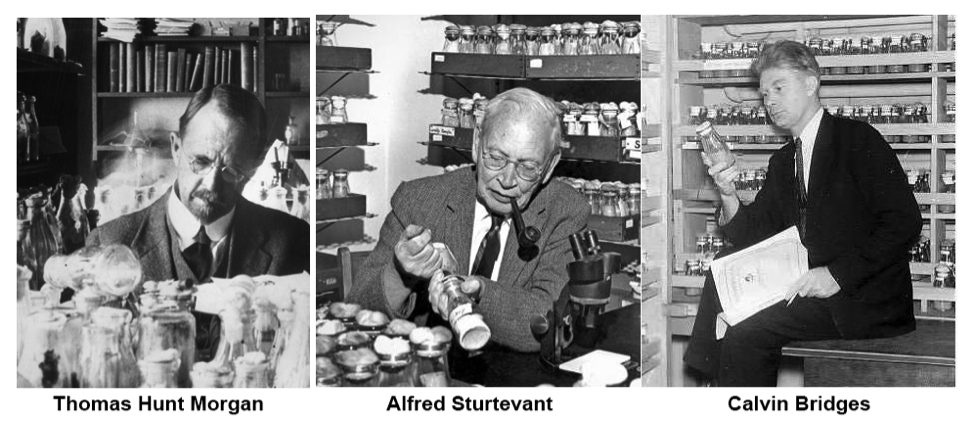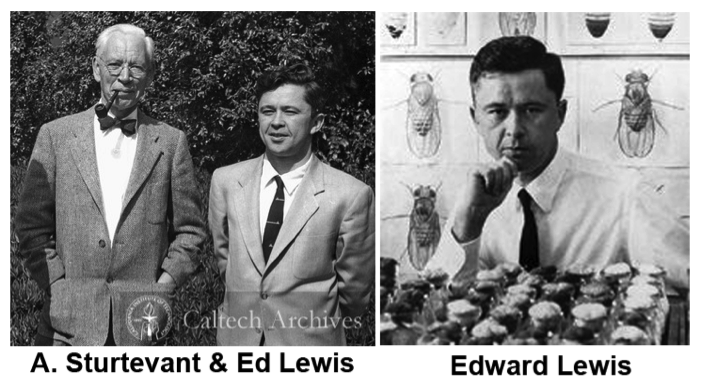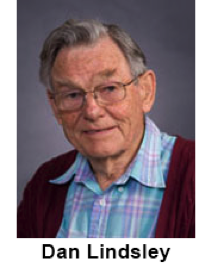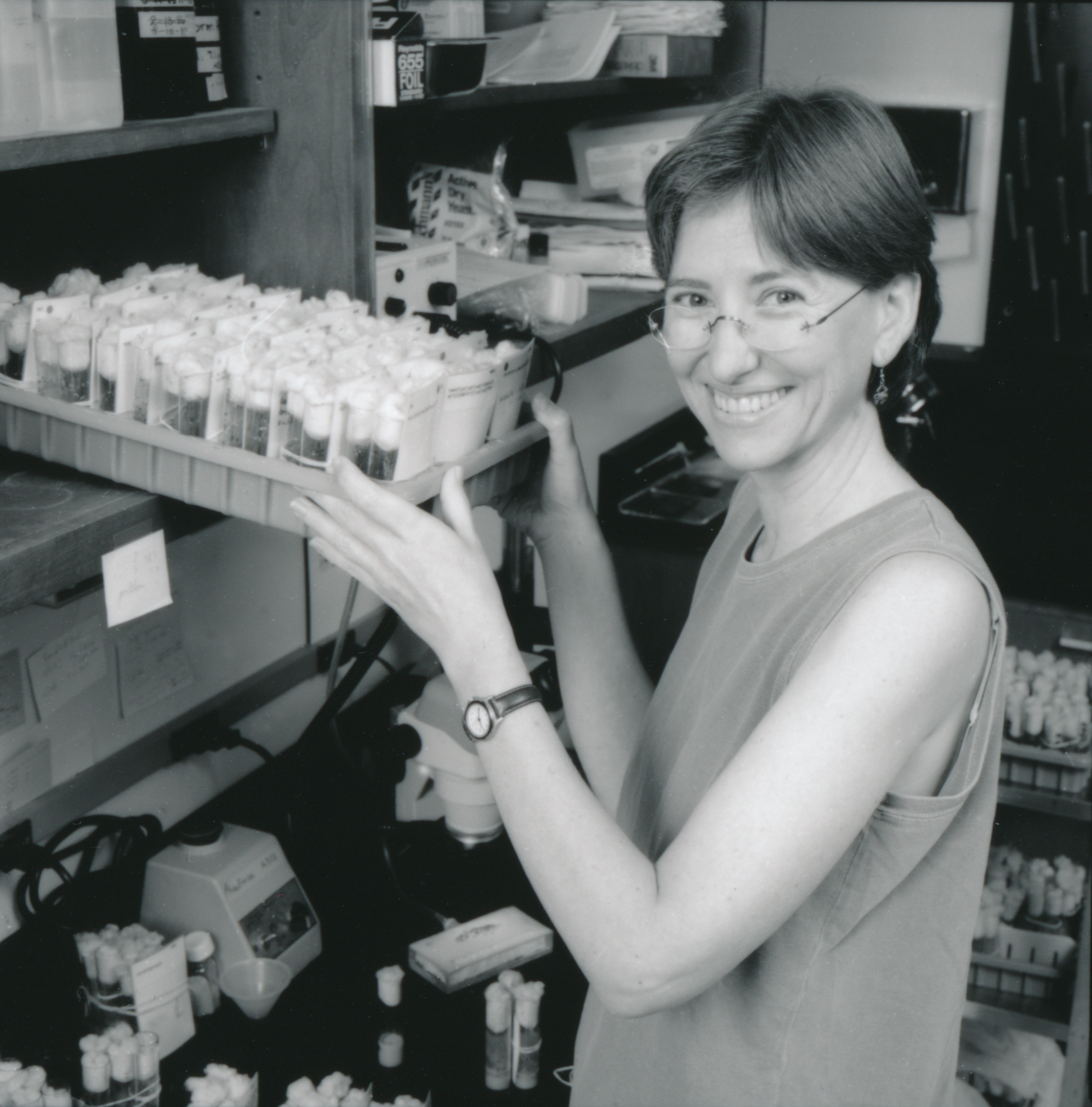| Year | Events or Milestones |
|---|
1913 | T.H. Morgan's group at Columbia began using Drosophila in genetic studies; C. Bridges maintained a collection of stocks produced by the group and provided samples to anyone requesting them. |
1928 | Morgan, Sturtevant, Bridges, and the stock collection moved to Caltech |
1934 | The first Caltech stock list was published in D.I.S., consisting of 572 stocks |
1948 | E.B. Lewis took responsibility for the collection at Caltech, continued until retirement; scientific staff included Rhoda Grell, Terry Johnson and Loring Craymer. |
1986 | The collection of 1,675 stocks moved to Indiana under the management of T.C. Kaufman & K.A. Matthews; significant expansion of holdings undertaken; funded by a grant from NSF; ~1,000 subcultures distributed. The first stock shipment from Bloomington was mailed on October 15, 1986 (to J. Roote, University of Cambridge, #1936 Df(3R)cu/TM3 and #1657 cu[1] kar[2]). |
1989 | Bloomington Stock Center Advisory Committee established, consisting of M. Ashburner, V. Finnerty, B. Judd, C. Langley, D. Lindsley, A. Spradling and B. Wakimoto; Bloomington Deficiency Kit established; collection at about 2,600 stocks; ~3,350 subcultures distributed. |
1995 | User fees implemented, grant funding provided jointly by NSF and NIH under NSF award Number DBI-9403760. Collection at about 4,800 stocks; ~25,500 subcultures distributed. |
1996 | A new Stock Centers Advisory Committee, appointed by the Drosophila Governing Board and charged with advising both the Bloomington and Mid-America Centers, established: D. Lindsley, M. Ashburner, H. Bellen, N. Perrimon, S. Hawley; ~32,500 subcultures distributed. Support provided by NSF & NIH under NSF Award Number DBI-9403760. |
1997 | Kevin Cook joined the scientific staff. Mid-America Center closed, about a quarter of those stocks moved to Bloomington. K. Golic replaced D. Lindsley on the Advisory Committee. Collection at about 6,000 stocks; ~38,150 subcultures distributed. Support provided by NSF & NIH under NSF Award Number DBI-9403760. |
1998 | Collection at about 6,800 stocks; ~49,700 subcultures distributed. Support provided by NSF & NIH under NSF Award Number DBI-9403760. |
1999 | Collection at about 7,000 stocks; A. Simcox replaced K. Golic on the Advisory Committee; ~ 71,000 subcultures distributed. Grant funding provided jointly by NSF and NIH under NSF award Number DBI-9816125. |
2000 | Collection at about 7,880 stocks; U. Heberlein replaced S. Hawley on the Advisory Committee; ~85,650 subcultures distributed. Support provided by NSF & NIH under NSF Award Number DBI-9816125. |
2001 | Collection at about 9,000 stocks; NIH funding increased, allowing the collection to plan an expansion to 15,000 stocks; a new fee structure replaced ranges of flat-fees with a per-stock charge; ~86,000 subcultures distributed. Support provided by NSF & NIH under NSF Award Number DBI-9816125. |
2002 | The collection had about 11,600 stocks at the end of the year and distributed ~107,400 subcultures. Support provided by NSF & NIH under NSF Award Number DBI-9816125. |
2003 | The collection had about 14,150 stocks at the end of the year and distributed ~128,000 subcultures. Support provided by NSF & NIH under NSF Award Number DBI-9816125. |
2004 | Stacy Holtzman joined the staff as the Center's first Research Associate. Susan Parkhurst replaced U. Heberlein on the Advisory Committee. The collection had about 19,300 stocks at the end of the year and distributed ~153,500 subcultures. Support provided by NSF & NIH under NSF Award Number DBI-9816125 (January-July) and DBI-0342468 (August-December). |
2005 | HHMI provided funds to renovate and equip an efficient, high-volume media kitchen and to convert the existing kitchen space to high-capacity, temperature-controlled space for stocks. The collection had about 20,570 stocks at the end of the year and distributed ~158,400 subcultures. Support provided by NSF & NIH under NSF Award Number DBI-0342468. |
2006 | Ken Burtis replaced M. Ashburner on the Advisory Committee. The collection held about 21,300 stocks at the end of the year and distributed ~163,600 subcultures. Support provided by NSF & NIH under NSF Award Number DBI-0342468. |
2007 | Luke Jacobus joined the staff as Laboratory Manager. The collection held about 23,250 stocks at the end of the year and distributed ~155,500 subcultures. Support provided by NSF & NIH under NSF Award Number DBI-0342468. |
2008 | The collection held about 24,850 stocks at the end of the year and distributed ~165,300 subcultures. Support provided by NSF & NIH under NSF Award Number DBI-0342468. |
2009 | Annette Parks joined the scientific staff as Collections Manager. The collection held 27,376 stocks at the end of the year and distributed ~166,150 subcultures. Support provided by NSF & NIH under NSF Award Number DBI-0342468 & DBI-0841154. |
2010 | HHMI provided renovation funds that will allow expansion of the collection to 60,000--70,000 stocks. The collection held 30,810 stocks at the end of the year and distributed 196,930 subcultures. Support provided by NSF & NIH under NSF Award Number DBI-0841154. |
2011 | Luke Jacobus departed and Kim Cook joined the staff as Laboratory Manager. The collection held 38,424 stocks at the end of the year and distributed 214,718 subcultures. Support provided by NSF & NIH under NSF Award Number DBI-0841154. |
2012 | The collection held 44,904 stocks at the end of the year and distributed 222,981 subcultures. Support provided by NSF & NIH under NSF Award Number DBI-0841154. |
2013 | The collection held 50,289 stocks at the end of the year and distributed 228,432 subcultures. Support provided by NSF & NIH under NSF Award Number DBI-0841154. |
2014 | Ruth Binkley retired and Jane Stout joined the staff as Accounts Manager. As of August 1, 2014, grant support is provided by the Office of Research Infrastructure Programs (ORIP) of the National Institutes of Health under Award Number P40OD018537 (ORIP, NIGMS and NICHD are the contributing ICs). The collection held 53,736 stocks at the end of the year and distributed 236,340 subcultures. |
2015 | Lily Golden and Ellen Popodi joined the project as Research Associates. Lily is focusing on the allele mapping component of our NIH grant. Ellen is contributing to a range of tasks with a focus on quality control. The collection held 58,874 stocks at the end of the year and distributed 243,148 subcultures. Support provided by NIH Award Number P40OD018537 (ORIP, NIGMS and NICHD are the contributing ICs). We also obtained supplemental funding for characterization of unmapped complementation groups (P40OD018537-02S1) from the ORIP. |
2016 | Cale Whitworth and Sam Zheng joined the BDSC as Associate Directors. The collection held 59,126 stocks at the end of the year and distributed 217,072 subcultures. Support provided by NIH Award Number P40OD018537 (OD, NIGMS and NICHD are the contributing ICs). |
2017 | The collection held 67,634 stocks at the end of the year and distributed 218,429 subcultures. Support provided by NIH Award Number P40OD018537 (ORIP, NIGMS and NICHD are the contributing ICs). NINDS provided supplemental funding (P40OD018537-04S1) for acquisition and maintenance of the Janelia Research Campus split-GAL4 stocks. |
2018 | Jessica Holsopple joined the BDSC as Research Associate. The collection held 70,970 stocks at the end of the year and distributed 222,975 subcultures. Support provided by NIH Award Number P40OD018537 (ORIP, NIGMS and NICHD are the contributing ICs). Kevin Cook and Nicholas Sokol were awarded R21OD026525 to characterize split-GAL4 expression patterns in the Drosophila gut. |
2019 | Mike Dixon joined the team as a Research Associate in charge of quality control. Lily Golden departed the BDSC and Ellen Popodi transitioned to executing the BDSC's research program. Sam Zheng and Cale Whitworth were promoted to Co-Directors of the center. In March, as part of our disaster preparedness planning, we opened a new facility across campus for the backup copy of the collection. Support was provided by NIH Award Number P40OD018537 (ORIP, NIGMS and NICHD are the contributing ICs). We renewed the 5-year NIH award that will subsidize the BDSC until August 2024. The collection held 76,191 stocks at the end of the year and distributed 204,672 subcultures. |
2020 | During 2020, BDSC stockkeepers, true heroes of the Drosophila research community, cared for over 150,000 independently maintained fly strains in an ongoing pandemic. COVID-19 shut down Indiana and Indiana University in late March. We halted stock shipments from late March to late May, stopped all non-essential activity, and spread out into empty classrooms to keep stockkeepers safe. The tremendous and selfless effort by our stockkeepers and fly kitchen staff kept the collection alive through a very difficult year and was recognized in a New York Times article. We cannot thank them enough for all their hard work and dedication. The collection held 76,940 stocks at the end of the year and distributed 160,105 subcultures. Support was provided by NIH Award Numbers P40OD018537 (ORIP, NIGMS, NINDS and NICHD are the contributing ICs) and P40OD018537-07S1. BDSC research was partially supported by R21OD026525. |
2021 | The collection held 79,005 stocks at the end of the year and distributed 185,018 subcultures. Support was provided by NIH Award Number P40OD018537 (ORIP, NIGMS, NINDS and NICHD are the contributing ICs) and P40OD018537-07S2. |
2022 | Jim Smotherman joined the BDSC as a web and database programmer. The collection held 81,736 stocks at the end of the year and distributed 171,299 subcultures. Support was provided by NIH Award Number P40OD018537 (ORIP, NIGMS, NINDS and NICHD are the contributing ICs), P40OD018537-08S1 and P40OD018537-08S2. |
2023 | Stephanie Mauthner joined the BDSC as an Associate Research Scientist. The collection held 87,912 stocks at the end of the year and distributed 171,706 subcultures. Support was provided by NIH Award Number P40OD018537 (ORIP, NIGMS, NINDS and NICHD are the contributing ICs) and P40OD018537-07S2. |
2024 | Maureen Lamb joined the BDSC as an Assistant Research Scientist. The collection held 90,282 stocks at the end of the year and distributed 156,466 subcultures. Support was provided by NIH Award Number P40OD018537 (ORIP, NIGMS, NINDS and NICHD are the contributing ICs). This 5-year NIH award, which subsidizes the BDSC, was renewed until August 2029. |
2025 | The collection held 91,445 stocks at the end of the year and distributed 148,666 subcultures. Support was provided by NIH Award Number P40OD018537 (ORIP, NIGMS, and NINDS are the contributing ICs) and P40OD018537-12S1. |





